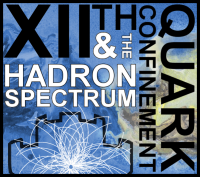Speaker
Description
Huge magnetic fields (MF) up to eB value of the order of the QCD Lambda square are created
for a short time in peripheral heavy ion collisions at RHIC and LHC.The field about four
orders of magnitude less is anticipated to operate in magnetars.This brought about an
extraordinarly large interest to the behavior of quark systems (mesons and baryons) in strong MF.In a series of papers we developed a relativistic formalism for any composed system in MF and evaluated the mass spectrum and the wave functions of mesons and baryons
( rho-, pion, neutron, proton) as a function of the MF strength.To separate the internal degrees of freedom we make use of pseudomomentum which commutes with the Hamiltonian in MF and takes the role of the center-of-mass momentum.The quarks Green's functions are taken in the Fock-Feynman-Schwinger representation.The confinement and color Coulomb interactions are derived using the minimal Wilson loop.The dynamical quark masses are introduced via the Dirac einbein formalism.The end-result is the relativistic Hamiltonian to which the additional hyperfine spin-spin interaction is added.As anticipated,the hadron wave function takes the form of an elongated ellipsoid in the MF direction with its size along the MF restricted by the confining string tension.Important to note that for the RHIC and LHC MF values the Landau magnetic radius becomes of the order,or smaller,than the hadron size and therefore the hadron mass problem should be solved at the quark level.For the quark system the question is whether MF induces the "fall to the center" phenomenon (zero mass value).We present negative answer to this question.The hadron mass trajectories vs MF values agree with lattice results in cases the latter are available
Summary
The relativistic formalism for any composed system (from atoms to hadrons) embedded in
arbitrary strong magnetic field (MF) is developed.The mass spectrum and wave functions
of mesons and baryons made of light quarks as functions of MF strength are evaluated.
For the maximum field values reached at RHIC and LHC the masses of the ground states
significantly decrease but zero mass value remains unattainable.
